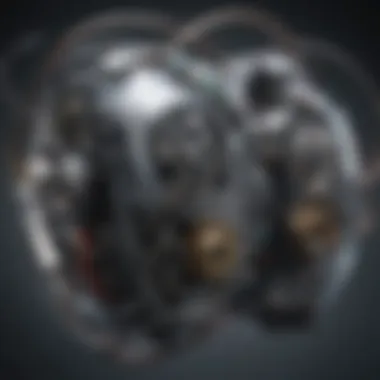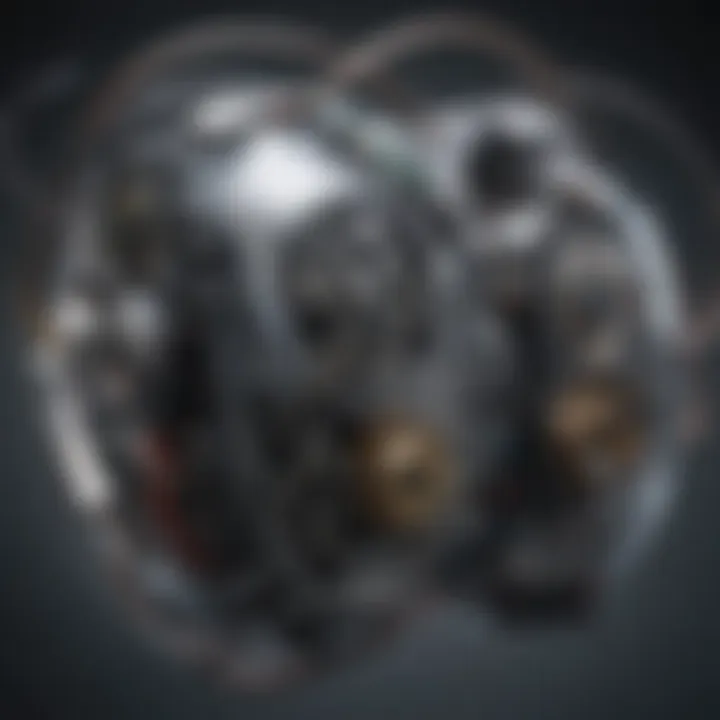Innovations in Left Ventricular Assist Devices


Intro
The landscape of cardiovascular treatment is constantly changing, driven by an urgent need to address heart failure. Left ventricular assist devices (LVADs) serve as a beacon of hope for patients with severe heart conditions, providing crucial support to a failing heart. This advanced technology is not just a temporary fix; it's a life-extending tool that continues to evolve.
Exploring the recent advancements in LVAD technology is essential for those involved in healthcare—be it clinicians, researchers, or students. These innovations have the potential to significantly enhance patient outcomes while keeping ethical considerations in mind. The implications of these developments ripple through the entire heart failure treatment paradigm.
The improvements in LVADs encompass several dimensions: the mechanics that underpin their functionality, design enhancements that boost compatibility, and emerging trends that point toward the future. By diving into these advancements, we can better appreciate how they are reshaping the approach to heart failure management today and tomorrow.
Summary of Objectives
This article aims to provide a comprehensive overview of the latest advancements in LVAD technology. We seek to inform and engage a variety of readers, from students to seasoned professionals, about the implications these advancements hold for heart failure treatment and overall patient care.
Importance of the Research
Understanding the nuances of LVAD innovation is crucial. As this technology evolves, so does our ability to manage heart conditions effectively, extend lives, and improve quality of life. This research underscores the vital role tools like LVADs play in modern medicine, while also highlighting the challenges and considerations that accompany such transformative technologies.
Results and Discussion
Presentation of Findings
The findings of recent studies reveal a host of advancements in LVAD technology. New models are integrating smaller, more efficient pumps that minimize the invasive nature of surgery while being easier to implant.
- Miniaturization: Recent LVADs are now comparable in size to a coffee cup, making them less invasive.
- Connectivity: Many new devices offer wireless monitoring capabilities, allowing for real-time health data sharing.
- Power sources: Improvements in battery technology enhance device longevity and patient mobility.
Implications of Results
The implications of these findings are far-reaching. Better-designed LVADs can lead to lower complications, reduced hospital stays, and greater patient satisfaction. As devices become more user-friendly, the burden on caregivers lessens, allowing families to focus on quality time rather than constant medical oversight.
"As we integrate technology with medicine, the future of heart failure treatment looks promising, paving the way for less invasive options that empower patients."
Preamble to LVAD Technology
The realm of cardiovascular care has seen remarkable transformations, particularly with the introduction and evolution of Left Ventricular Assist Devices (LVADs). These devices play a pivotal role in the management of severe heart failure, acting as a bridge to heart transplantation or even as a long-term solution for patients who are not suitable candidates for surgical procedures. The strides made in LVAD technology reflect not only advances in engineering but also a dedication to improving patient outcomes and quality of life, making this topic one of considerable importance to both healthcare professionals and researchers.
Definition and Purpose
Left Ventricular Assist Devices are mechanical pumps designed to support heart function by increasing blood flow from the left ventricle to the aorta. To put it succinctly, LVADs are lifelines for those suffering from heart diseases. They come into play when the heart's natural pumping ability is inadequate, essentially bridging the gap while waiting for transplant or offering a solution for long-term management. The purpose of LVAD technology extends beyond mere survival; it embodies a commitment to enhancing patients' day-to-day existence, providing them a chance to engage in activities that many take for granted. These devices also tailor treatment methodologies based on individual patient needs, which is a significant evolution in personalized medicine.
Historical Context
Understanding the historical backdrop of LVAD technology helps illuminate the path that has led to the current innovations. Initially, in the late 20th century, LVADs were treated with skepticism due to their complexity and the perceived risks linked to implantation. Early versions resembled bulky machinery, often leading to complications and a limited lifespan. However, as the technology progressed, so did its acceptance and application.
By the early 2000s, advancements in miniaturization and materials science began to redefine what was possible. Devices became smaller, more efficient, and easier to implant. The introduction of continuous-flow LVADs marked a significant milestone, as these models proved to be more durable and easier for patients to manage. Studies emerged demonstrating improved survival rates and quality of life for patients equipped with these devices. Thus, what was once an experimental procedure began evolving into a mainstream option for heart failure treatment, showcasing a remarkable fusion of innovation and patient care. The evolution of LVADs symbolizes a broader trend in medicine where technology marries compassion to create effective solutions for complex health challenges.
"The relentless march of technology in LVAD development underscores our ongoing commitment to enhancing patient outcomes."
Today, LVADs are no longer regarded simply as temporary interventions but rather as comprehensive tools that can dramatically alter the trajectory of cardiovascular health. With numerous advancements on the horizon, this topic holds vital implications for the future as well, offering a glimpse of what modern medicine can achieve in the quest to address heart failure and improve lives.
Current Landscape of LVAD Devices
The field of left ventricular assist devices, or LVADs, has gone through vast changes in recent years. Understanding the current landscape of LVAD devices is essential, not just for healthcare professionals, but also for patients and their families. As technology has evolved, so too have the designs and functionalities of these devices. Today’s LVAD systems offer more than just mechanical support for the heart; they integrate advanced technologies for better patient management and outcomes.
Overview of Existing Models
Currently, several models of LVADs are making their rounds in the market, each with its strengths and weaknesses. The most popular models include the HeartMate 3, the Jarvik 2000, and the AbioCor. These devices each bring a unique set of features tailored for differing patient needs.
- HeartMate 3: Known for its innovative design, this device utilizes a centrifugal pump mechanism. Its compact size and reduced axial flow support have resulted in lower thrombosis rates when compared to older models.
- Jarvik 2000: This device is notable for its small size and the ability to be implanted in patients with lower body surface areas. The Jarvik 2000 is also designed to minimize blood trauma, which significantly improves patient compatibility.
- AbioCor: As a total artificial heart solution, the AbioCor offers a distinct pathway for patients with end-stage heart failure. It's equipped with a unique system allowing it to function independently of the body's own heart.
These LVADs have been a game-changer in treating patients who previously had limited options. However, they each have specific considerations, including risks associated with surgery and long-term management.
Performance Metrics
When evaluating LVADs, performance metrics become a critical focal point. These metrics help assess how well the devices function and ultimately assist in guiding clinical decisions. Key performance indicators often analyzed include:
- Survival Rates: The percentage of patients making it to specific milestones post-implantation, such as six months or two years. High survival rates indicate success in preserving life quality and longevity.
- Quality of Life Assessments: It includes patient-reported outcomes that reflect how living with an LVAD affects everyday life.
- Pump Flow Rates: This indicates the volume of blood the device can effectively circulate per minute. A higher pump flow rate often correlates with improved cardiac output.
- Hospital Readmission Rates: Monitoring how often patients are readmitted due to complications or device failures can reveal a lot about a particular model's reliability.
The metrics not only highlight how these models perform in clinical settings but also open discussion about patient care and future innovations. By paying attention to these factors, clinicians can better strategize management protocols that ultimately improve patient outcomes.


"Vigilance in monitoring patient response and device function can indeed save lives and ensure a better quality of life."
As we transition to discussing innovative design features, it will be imperative to reflect on how technological advancements can continue to push the envelope in enhancing LVAD reliability and overall patient care.
Innovative Design Features
Innovative design features play a pivotal role in the ongoing evolution of left ventricular assist devices (LVADs). As heart failure is becoming increasingly prevalent globally, advancements in LVAD technology are crucial not only for enhancing patient outcomes but also for increasing the efficiency of treatment protocols. A focus on design improvements contributes significantly to the operational performance and long-term success of these devices.
Miniaturization Trends
One of the most noteworthy trends in LVAD development is the miniaturization of devices. This progression stems from the desire to create less intrusive solutions for patients. Smaller devices reduce the surgical footprint and the overall impact on the patient's lifestyle. It is interesting to note that many manufacturers have turned towards innovative materials like titanium and specialized polymers, which provide impressive strength without adding bulk. This shift often results in devices that can be implanted using minimally invasive procedures, allowing patients to recover faster and experience less discomfort.
Patients often feel overwhelmed with the thought of being tethered to bulky machinery. Consequently, these lighter, more compact LVAD models can substantially boost the patient’s quality of life, enabling them to maintain a sense of normalcy post-operation. As a specific example, the HeartMate 3 showcases this trend well, offering a device that’s significantly smaller than its predecessors while maintaining or improving on performance levels.
Durability Improvements
Durability in LVAD technology should not be underestimated. With the continuous advancements, manufacturers are now focusing on longevity and reliability as key attributes. Historically, one of the primary concerns with LVADs was the potential for device malfunction or component failure, which could lead to serious health implications for patients. New materials and engineering improvements have paved the way for devices that exhibit enhanced resistance to wear and tear.
The introduction of several new protective coatings and robust design methods means that modern LVADs can withstand the wear and tear of regular use, effectively limiting the risk of complications caused by device failure. Patients no longer need to worry as much about frequent replacements or repairs. An excellent case in point would be the advancements seen in the intra-aortic balloon pump technology, which have influenced LVAD designs, leading to increased lifespan and reduced incidence of mechanical failure.
Biocompatibility Advances
Biocompatibility is another cornerstone of modern LVAD innovations. The interaction between the device's materials and the human body can profoundly influence patient outcomes. Materials that cause less immune response are preferred, which aids in reducing complications related to thrombosis and infection. As medical science has advanced, researchers have explored the use of biologically compatible coatings and advanced polymers that integrate more seamlessly with bodily tissues.
The effort to improve biocompatibility not only minimizes the risk of rejection but also enhances overall device performance. For instance, the Freedom® Drive System has made notable strides in this area, incorporating materials that promote better blood flow with reduced hemolysis, which can improve the overall safety and efficiency of the device.
Ultimately, the combination of miniaturization trends, durability improvements, and advances in biocompatibility reflects a concerted effort to not only improve the effectiveness of LVADs but to also put the patient's comfort and safety at the forefront of new developments. As we view these trends collectively, it becomes clear that innovative design features are integral in reshaping the future of heart failure treatments with left ventricular assist devices.
"With advancements in LVAD technology, we are witnessing a transformation that directly impacts patient lives, enhancing not just survival rates but the quality of everyday existence."
By continuing down this ambitious path, the field of LVAD technology stands to gain even more significant advancements that could revolutionize patient care in the years to come.
Technological Integration
The fusion of cutting-edge technology with left ventricular assist devices (LVADs) has ushered in a new era that promises to reshape how we manage heart failure. This integration is not merely an enhancement of the existing frameworks; it's about creating a seamless interaction between man and machine. Significant aspects of technological integration focus on developing systems that cater to patient needs, elevating treatment protocols, and ultimately, improving clinical outcomes.
Wearable Technology
Wearable technology has made a substantial footprint in the LVAD landscape. Devices like heart rate monitors, smartwatches, and specialized wearables have transitioned from being just fitness gadgets to vital tools in managing heart health. They can provide real-time feedback, capturing essential data about a patient’s physiological state. This integration allows patients and clinicians to stay connected without the need for frequent clinic visits.
The relevance of wearable technology in LVAD management cannot be overstated. Patients benefit from the continuous monitoring of parameters such as heart rate variability and activity levels. This data enables proactive interventions, reducing the risks of adverse events. Long gone are the days when patients would wait for an appointment to learn about their health metrics. Now, they can view their data almost instantly.
Moreover, wearables can alert users to irregularities, prompting immediate action.
- Potential Benefits of Wearable Technologies:
- Real-time Health Monitoring: Constant oversight of patient vitals.
- Enhanced Patient Engagement: Individuals become more proactive about their health.
- Data-Driven Decisions: Clinicians can base their treatment adjustments on robust data.
Remote Monitoring Systems
Similarly, remote monitoring systems are changing the game. These systems link patients with healthcare providers through the cloud, allowing for a virtual bridge that keeps everyone in sync. With remote monitoring, clinicians can access patient data from anywhere, enabling timely feedback and support without necessitating in-person visits.
This technological upgrade holds particular significance for those on LVAD support, where condition stability is paramount. By utilizing telehealth strategies, providers can address complications, track recovery, and refine treatments based on accurate, immediate information.
Key elements in remote monitoring systems include:
- Secure Data Transfer: All patient information is transmitted in compliance with privacy regulations.
- Alerts and Notifications: Any significant events trigger notifications to both the patient and healthcare team.
- User-Friendly Interfaces: Simple applications ensure high levels of engagement from both providers and patients.
"The future of LVAD care rests not only on the devices themselves but also on how effectively we can harness technology to monitor and improve patient lives."
The integration of wearable technology and remote monitoring systems underscores the importance of innovation in managing heart failure. As these advancements continue to unfold, they are set to break barriers, lessen complications, and ultimately, improve the quality of life for patients reliant on LVADs.
Regulatory and Approval Processes
In the fast-evolving realm of left ventricular assist devices (LVADs), regulatory and approval processes play a pivotal role in ensuring that these life-saving technologies are not only innovative but also safe and effective. The involvement of regulatory bodies, particularly the Food and Drug Administration (FDA) in the U.S., ensures a structured pathway for new devices, which is crucial in a field where mishaps can carry severe consequences for patients with heart failure. Understanding these processes provides insight into how advancements in LVAD technology can effectively transition from concept to clinic.
FDA Guidelines


The FDA lays down the law when it comes to the approval of LVADs. Their guidelines encompass a wide range of criteria aimed at assessing the safety and efficacy of new devices. First and foremost, manufacturers must provide evidence that their product meets rigorous performance standards. This includes a thorough examination of how the device operates under various conditions, its reliability over time, and its compatibility with a patient’s biology.
Moreover, the FDA classifies LVADs as Class II or III devices, depending on their complexity and the potential risk they pose. Class III devices, which are generally more complex and riskier, demand premarket approval (PMA) rather than just clearance through the 510(k) process. Consequently, developers must conduct extensive clinical trials to demonstrate both safety and effectiveness. This usually involves several phases of trials, where the device is tested in progressively larger groups of patients.
Adhering to these guidelines offers several benefits, including:
- Enhanced Patient Safety: Regulatory oversight helps minimize risks associated with new technologies.
- Market Trust: Approval from the FDA often boosts confidence among clinicians and patients regarding a device's reliability.
- Clinical Evidence: The requirements for clinical trials generate invaluable data that can improve future device iterations.
The FDA continues to adapt its guidelines to keep pace with technological advancements. For instance, they’ve embraced the methods of real-world evidence and adaptive trial designs, which aim to streamline approval processes without compromising safety standards.
Clinical Trials and Studies
The backbone of the regulatory approval process for LVADs lies in clinical trials and studies. These trials are categorized into different phases, each serving a distinct purpose and contributing to a comprehensive understanding of the device's impact on patient outcomes.
Firstly, Phase I trials primarily assess safety in a small group of participants. They focus on identifying adverse effects and determining the initial interactions with the human body. If a device passes this stage, it moves to Phase II, where a larger group of patients is involved, and efficacy along with safety is evaluated.
Phase III trials are typically the most extensive, often encompassing hundreds or even thousands of participants. Here, the device is compared against standard treatment options, aiming to understand its relative effectiveness in improving survival rates or quality of life. This phase generates the bulk of the data that regulatory bodies like the FDA rely on for decision-making.
Post-marketing studies, or Phase IV trials, exist outside of the standard approval process. These studies continue to monitor the device’s performance in the general population, helping to identify any long-term complications or unexpected effects that may not have appeared in earlier trials.
In summary, the rigorous regulatory and approval processes, complemented by comprehensive clinical trials, enable the safe introduction of innovative LVAD technology. The journey from a groundbreaking idea to a device in a patient’s chest is fraught with complexity, but it ultimately ensures that meaningful advancements can be made in the treatment of heart failure.
Patient Outcomes and Quality of Life
Understanding decisions surrounding left ventricular assist devices (LVADs) isn’t just about the mechanics or the technology itself. It extends to the very core of patient experiences and how these devices influence overall quality of life. Patients with heart failure face numerous challenges, and their outcomes post-implantation are critical metrics that guide both current practices and future innovations. As LVAD technology continues to evolve, examining patient outcomes sheds light on the effectiveness of these systems in transforming lives.
Identifying the importance of patient outcomes encompasses a variety of elements. Among these is the survival rate, a profound indicator of the efficacy of LVAD devices. Ensuring the longevity of these patients boosts overall statistics and provides hope where once there may have been despair. The benefits aren’t just physical; they also extend to mental health. When patients realize they have a shot at an extended life, their outlook can dramatically improve.
Additionally, quality of life essentially revolves around the daily experiences of patients living with these devices. The ability to re-engage in regular activities—be it simple walks or attending family gatherings—brings joy and fulfillment back to patients, which is just as important as raw survival rates. It’s not merely about the existence; it’s about the degree of satisfaction and well-being during that existence.
Beyond just statistical measures, one must consider the nuances of living with an LVAD. Patients can face psychological hurdles, needing to adjust to the realities of having a mechanical device supporting their heart, which can lead to anxiety, stress, and even post-traumatic symptoms. Thus, holistic care, integrating mental health support, becomes essential for improved outcomes.
"Technology can’t fully replace the human experience; it must enhance it to be worthwhile."
This perspective leads to discussions around postoperative complications—unfortunately, no surgical procedure comes without risks. An overview of these complications is vital in providing a realistic picture of life with an LVAD and ensuring that patients have the information necessary to make informed decisions about their health.
Survival Rates
Survival rates serve as a cornerstone metric for assessing the impact of LVAD technology. In reality, the figures speak volumes about both the advancements in cardiac devices and the underlying improvements in surgical techniques. Recent analyses show that the one-year survival rates for LVAD patients near 80 to 90 percent. This statistic is significant when contrasted with earlier devices, which might not have provided similar outcomes.
However, it’s not merely the numbers that count. The context within which these rates stem carries weight as well. Factors such as age, health condition prior to the LVAD implantation, and even organ function play a crucial role in these survival statistics. Therefore, while high survival rates are encouraging, they don’t apply uniformly to all patients. Moreover, ongoing research aims to fine-tune candidacy criteria for LVAD implantation, ensuring that those who stand to benefit most are prioritized.
Postoperative Complications
Managing postoperative complications is where the rubber really meets the road. Not every outcome after LVAD surgery is favorable, and complications can range from minor inconveniences to serious health risks. Common challenges include infections at the surgical site, device thrombosis, and even pump failures. The interdependence of these complications creates a challenging landscape for post-operative care.
Living with the LVAD, some patients also experience bleeding, which can stem from anticoagulation therapy aimed at preventing clots. The need to balance managing these risks while also maximizing the patients’ quality of life can be a tightrope walk.
In essence, the trajectory of patient outcomes and quality of life in LVAD technology offers a complex picture, intertwining hope with realism. As research develops, ongoing advancements must focus not only on elevating survival rates but also on enhancing the quality of patients' lives. Through multidisciplinary approaches, including psychological support and meticulous post-operative care, the promise of LVAD technology can reach its fullest potential.
Ethical Considerations
The topic of ethical considerations surrounding LVAD technology is crucial, encompassing various dimensions that influence both patients and healthcare systems. As advancements in left ventricular assist devices evolve, it becomes increasingly urgent to address the implications of this technology beyond its mechanical capabilities. Key aspects include equitable access to devices, informed consent processes, and the challenges that arise when considering end-of-life situations for patients who might rely on these technological marvels.
Access to Technology
One significant ethical dilemma in the realm of LVAD devices is access to this vital technology. Not every patient in need of an LVAD can acquire them due to financial barriers or healthcare disparities. While insurance companies may cover a portion of the costs involved, many patients find themselves navigating a labyrinth of paperwork and procedures that can delay or obstruct access altogether.
Different populations face varying degrees of access, largely influenced by socioeconomic factors. For instance, patients from low-income backgrounds might not only struggle with the upfront costs but also the ongoing expenses related to maintenance and management of device complications. This discrepancy raises questions regarding fairness in treatment and whether all patients receive equal opportunities for beneficial outcomes.
- Financial Inequities: The disparities in health insurance coverage can lead to an uneven playing field for patients seeking an LVAD.
- Awareness and Knowledge: Some individuals may not even be aware that LVADs are an option due to lack of access to quality healthcare information, leading to underutilization.
"Access to life-saving technology is not just about availability; it’s about who gets privileged information and support to navigate complex systems."
End-of-Life Issues
As much as LVAD technologies can enhance life, they also prompt critical discussions regarding end-of-life considerations. Many patients reliant on these devices might find themselves in challenging situations that question the purpose and direction of their treatment.


The nature of LVAD use often becomes a double-edged sword: it can prolong life but might also prolong suffering if the device is used inappropriately or without clear understanding. Additionally, conversations about discontinuing LVAD support can be fraught with emotional and ethical complexities, leading to distress not only for patients but also for families and healthcare providers.
- Advanced Directives: Establishing advanced directives becomes crucial in ensuring patient preferences are honored as their conditions progress.
- Informed Decision-Making: Patients must be adequately informed about the implications of device use and the potential for various outcomes, including the reality of transitioning to palliative care when appropriate.
In summary, ethical considerations surrounding LVAD technology are multifaceted, blending access-related issues with dilemmas at the end of life. Engaging with these challenges demands a nuanced approach that values patient autonomy while recognizing systemic limitations. The goal should be to enable equitable access to life-extending devices, creating an environment where informed choices can be made and respected throughout the patient care continuum.
Future Directions in LVAD Technology
As the landscape for left ventricular assist devices (LVADs) continues to evolve, it becomes increasingly crucial to keep an eye toward future avenues of development. This section aims to shed light on potential shifts and innovations in LVAD technology that promise to enhance patient outcomes and address current challenges. Understanding future directions will not only benefit clinicians and researchers but also provide hope for patients battling heart failure. The commitment to innovation in this field underscores the importance of improving quality of life and survival rates for individuals affected by severe cardiac conditions.
Emerging Research Trends
Research into LVAD technology has gained significant traction in recent years. As the medical community strives to push the envelope further, several emerging trends stand out:
- Cellular Therapies: A notable area gaining attention involves regenerative medicine. Studies are exploring how stem cell therapies can possibly alleviate or reverse heart failure, potentially leading to a reduced reliance on mechanical devices. Meaning, the approach could go beyond mere support for the heart's function.
- Patient-Centric Design: Recent research indicates a strong push towards designing LVADs that not only prolong life but also enhance the user experience. This includes reducing device noise, improving usability, and ensuring comfort, indicating a holistic view towards patient care that factors in mental well-being.
- Artificial Intelligence Integration: The rise of AI offers new possibilities for LVAD management. From predictive analytics that can foresee and mitigate complications before they arise to advanced machine learning algorithms that personalize therapy based on real-time data—this blend of technology illustrates how the past and future collide dramatically. This shift can turn LVADs into smarter devices that adapt to patients' conditions.
"The future of LVAD technology is not about merely assisting the heart; it’s about reshaping the entire patient experience."
Potential Technological Breakthroughs
Potential breakthroughs loom on the horizon, signaling a significant advance in how LVADs function within the medical ecosystem. Key avenues include:
- Non-Invasive Power Sources: A game-changer in LVAD technology could be the development of external, non-invasive charging methods. Imagine a scenario where a patient's LVAD can be charged without physical contact, through the use of innovations like electromagnetic induction or solar technology which reduces the risk of complications from battery ports.
- Bioresorbable Materials: The exploration into using next-generation materials, like bioresorbable polymers, can revolutionize LVAD design. Such materials could eventually dissolve or integrate within the body, minimizing the long-term impacts and risks associated with device implantation.
- Personalized Device Models: As bioprinting technology matures, the prospect of customizing LVADs tailored specifically to individual anatomical needs could come to fruition. This step could ensure that devices are not only efficient but also comfortable, avoiding complications linked to poor fit.
In summary, the future directions of LVAD technology portray a landscape rich with potential avenues of development. From emerging research trends to groundbreaking technological innovations, the field is set to transform significantly. The ongoing commitment to improving the quality of life for patients reflects an evolution that goes beyond medical mechanics; it’s also about emphasizing the human element in health care.
Case Studies in LVAD Applications
A well-rounded examination of case studies reveals critical learnings that shape ongoing innovation in the field. By analyzing specific instances of LVAD usage, healthcare professionals can determine which approaches yield the best results, thus refining treatment protocols. Moreover, data gained from these studies can pave the way for new guidelines aiming at enhancing the quality of care for heart failure patients.
Longitudinal Studies
Longitudinal studies play a crucial role in LVAD research, allowing practitioners to observe and record the same patient population over extended periods. This approach provides rich data, illustrating how patient outcomes evolve with LVAD use across time. Health professionals gain invaluable insights into survival advantages, quality of life changes, and potential complications that can arise following device implantation.
For instance, a comprehensive longitudinal study conducted at a major cardiovascular center tracked the progress of 200 patients fitted with LVADs over a five-year span. The study highlighted the following key elements:
- Survival Rates: Patients showed a significant increase in survival rates post-implant.
- Quality of Life: Many experienced improvements in daily functioning, enabling a return to work or leisure activities.
- Complications: The investigation also forecasted common postoperative challenges such as infections or thromboembolic events, allowing for prompter interventions in future cases.
Such studies are not just academic exercises; they lay the groundwork for evidence-based practices, ensuring that advancements in LVAD technology meet the real needs of patients.
Comparative Analysis of Patient Outcomes
Comparative analysis of patient outcomes is one way the medical community ensures that advancements in LVAD technology are effective in improving care. This approach often examines groups of patients using different LVAD models or those who have undergone different surgical techniques.
By juxtaposing outcomes across various contexts, researchers can identify which factors significantly influence recovery and long-term success. In one notable comparative study published in a leading cardiovascular journal, patients using the HeartMate 3 versus the Jarvik 2000 were monitored. Findings included:
- Adaptation to Devices: Different LVADs elicited varied responses in patients, suggesting the need for personalized treatment plans.
- Hospital Stay Duration: It was found that patients using certain devices had shorter hospital stays, reflecting the efficiency of their respective designs.
- Emergency Interventions: Variances in side effects led to differing rates of emergency interventions, highlighting the significance of design choices.
These analyses amplify the dialogue surrounding LVAD technologies, providing essential feedback to designers and clinicians alike. Through these insights, future innovations are not just created based on theory, they are rooted in actual patient experiences, driving true progress in heart failure management.
"In-depth analyses of LVAD applications significantly influence future developments in cardiac care. Every case offers lessons that could transform our approach to heart failure treatment."
The convergence of longitudinal studies and comparative analysis creates a robust framework for understanding how LVADs function within various clinical scenarios, ensuring that advancements in this technology do not only remain theoretical but translate into meaningful, life-enhancing changes for patients.
Ending
The journey through the intricate world of left ventricular assist devices (LVADs) emphasizes their profound significance not just in clinical settings, but also in enhancing the overall quality of life for patients grappling with heart failure. Understanding how these devices work, their evolution, and the latest advancements brings several crucial elements to light.
Summary of Findings
Throughout this analysis, key findings have emerged about LVAD technology that underscore its importance:
- Innovative Design Improvements: The focus on miniaturization and biocompatibility in LVADs has led to devices that are not only more functional but also capable of better integration into patients' lives.
- Patient Outcomes: Studies robustly indicate that newer LVAD systems are linked with improved survival rates and lower postoperative complications, which has important implications for patient care.
- Technological Integration: The introduction of remote monitoring systems is making it easier for healthcare providers to keep tabs on patients, thus allowing for timely interventions as needed.
A close examination of these advancements reveals a trend towards devices that are increasingly patient-centered, showcasing how modern engineering is meeting the nuanced needs of those living with chronic heart conditions.
Final Thoughts on Future Impact
As we look towards the horizon, it's clear that the future holds significant promise for LVAD technology. The trends we currently observe—such as a push for more personalized treatment options and the integration of artificial intelligence into monitoring systems—are likely to reshape the landscape of cardiac treatment in ways that we can only begin to imagine. Moreover, addressing ethical considerations regarding access to this technology remains vital, as disparities could hinder equitable healthcare.
In summary, the advancements in LVAD technology serve as a beacon of hope, paving the way for not only improved treatment protocols but also better long-term outcomes for patients suffering from heart failure. As the engineers, clinicians, and researchers continue to innovate, it is the patients' stories and experiences that will drive the conversation and steer future developments.
"The challenge is not just to build newer devices, but to transform lives while doing it."
Ultimately, the intertwining of technology and human care is the crux of heart failure management moving forward.















